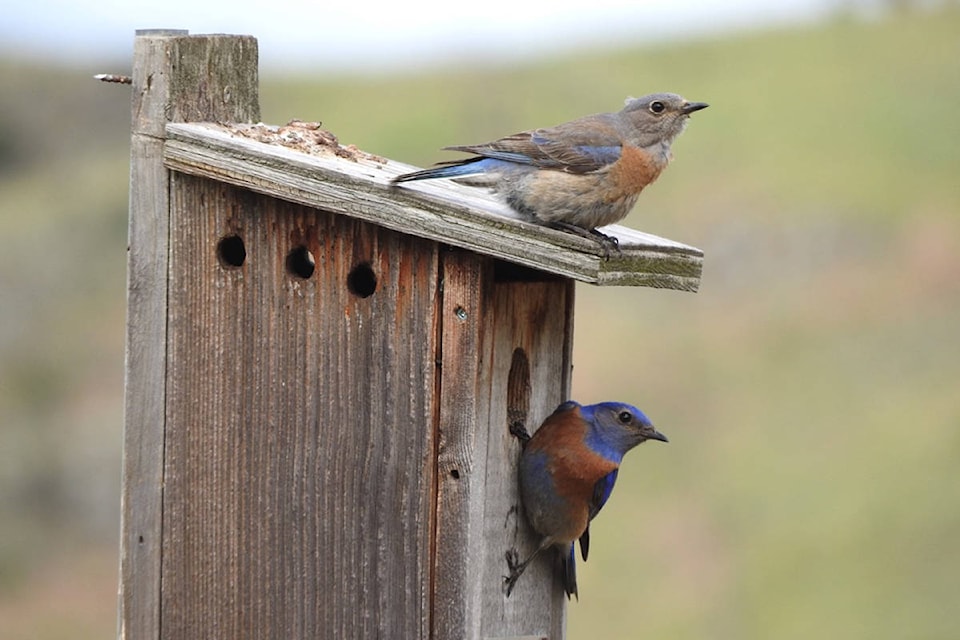Is building a nest box for birds a good idea?
Birds face all kinds of problems trying to raise young but one of the biggest is the invasive house sparrow, introduced from Europe more than 100 years ago.
They weren’t in Vernon in the 1950s when residents lived in town on extra large lots and bluebirds came and nested in their yards. However, today, Vernon is filled with house sparrows and unfortunately they are cavity-nesting birds like many of our native species such as bluebirds, chickadees, violet-green swallows, tree swallows, house wrens and nuthatches etc.
House sparrows are extremely aggressive and prevent the native species from successful nesting and raising their young. Eventually the native species leave the area.
Many people build and put up nest boxes with the best intentions of helping the birds but after a time the houses usually go unchecked and forgotten.
It’s easy to think, “I put up a box, the birds can take care of themselves, I’ll leave it to nature”. Other people with good intentions may put up a box in an area where there are house sparrows.
The house sparrows invariably enter the box, evict or kill the adult bluebirds, wwallows, wrens, chickadees etc. and build their nest over top of the eggs or babies in the nest. When you put up a nest box you have made a commitment to monitoring it, to watch over the birds inside to see that the box is a safe place and doing what it’s supposed to do: help the birds produce more generations of birds to carry on the species.
Monitoring a nest box or a nest box trail can be educational and many times incredibly rewarding.
The North Okanagan Naturalists’ Club (NONC) has operated a Bluebird Nest Box Program for more than 25 years and manages 18 nest box trails on farms and ranch lands in the surrounding Vernon area. The trails are called bluebirds trails to help bring back the Bluebird which had declined in North America dramatically due to DDT spraying, loss of habitat and the introduction of non-native house sparrows and starlings which filled existing nesting sites.
However, the trails are actually Nest Box Trails as they are for other cavity nesting species that utilize the same sized nest hole as bluebirds such as chickadees, swallows, wrens, and nuthatches.
The Nest Box Trails have from eight to 40 boxes which are placed on fence posts and spaced 100 metres or more apart. Each March the monitors check all boxes for leaks, gaps, damage etc, and make necessary repairs. Once the boxes are occupied weekly monitoring throughout the nesting period takes place.
Any problems during the long summer are dealt with as they arise, for example, if wasps and ants invade the nests they will cause birds to desert their young.
House sparrows and starlings are kept out of nest boxes as much as possible. Nest holes are checked for the correct size to keep out starlings which are larger birds. Boxes are removed from an area with too many house sparrows or sparrow-proofing methods are tried to keep house hparrows from nesting in boxes.
Every increase in their population has a detrimental effect on the native bird population.
Most bluebirds and tree swallows are quite tolerant of human monitoring and observation and monitors observe and record the species of birds, dates of egg laying, and numbers of chicks hatching and fledging. All results of all species are recorded and sent to the Southern Interior Bluebird Society which collects data from other B.C. sites.
Keeping records allows monitors to gain an understanding of the breeding and nesting behaviours of the various bird species and their young.
Our program cannot be complete without the support of many persons who volunteer their time during the summer to monitor the nest boxes. Most trails have substitutes to take over when the regular monitors go on holidays or are otherwise occupied.
The satisfying feeling from regularly checking the boxes and birds throughout their nesting cycle should be reason enough for monitoring a trail. Bluebirds especially are one of the few birds that readily accept human help and continuous observation as they seem to enjoyhuman interaction.
Walking your trail should not be considered work, but a privilege. It is rewarding to know that you are really making a difference.
Not everyone wants or needs to involve themselves in the amount of time that members of NONC spend monitoring nest boxes. However, having an understanding and knowledge of both the bird species you are putting up a nest box for, and building the nest box properly to keep the nesting birds safe, is necessary.
It is important to clean the boxes before and after nesting is completed and observe what is happening in the box on some sort of regular basis to keep the birds as safe and healthy as possible.
Our bluebird program would welcome anyone who would like to help monitor a trail in the Vernon area. We encourage families to come and join in our program.
Please contact: Margaret Mackenzie, co-ordinator, Bluebird Trails NONC, 250-542-2712.
A bluebird workshop open to all interested persons will be held at the Vernon Library on Saturday, April 7, from 1:30 - 3:30 p.m.
